Establishment of Crops under Minimal Soil Disturbance and Crop Residue Retention in Rice-Based Cropping System: Yield Advantage, Soil Health Improvement, and Economic Benefit
Abstract
:1. Introduction
2. Materials and Methods
2.1. Experimental Site
2.2. Treatments and Experiment Layout
2.3. Cropping Pattern and Variety
2.4. Preparation of Different Soil Management Plots and Seeds or Seedling Planting
- Zero tillage (ZT)—For the rice, plots were irrigated and flooded for 18–24 hours just immediately before transplanting and then 30-day old seedlings were manually transplanted directly into the wet, softened soil with a spacing of 25 × 15 cm. In case of lentil, jute and wheat, ZT was accomplished by one pass with a Versatile Multi–crop Planter (VMP) using a narrow furrow opener that opened a 2–3 cm wide and 1.0–1.5 cm deep slot maintaining 25 cm row spacing. Basal fertilizers were placed in the furrows below and to the side of the seed, respectively using VMP.
- Strip tillage (ST)—the seed/seedling zone (3–5 cm wide and 3–4 cm deep) was rotary tilled while the inter-row with crop residue retained was left undisturbed. The ST was accomplished by VMP using rotating blades maintaining 25 × 15 cm spacing and placing seed and fertilizer behind narrow furrow openers. In case of rice, first strip tillage was carried out and then the soil was flooded by irrigation for 18–24 hours before transplanting rice seedlings in the non–puddled strip. For sowing of lentil, jute, and wheat seeds, ST was done by one pass with VMP maintaining 25 cm spacing from row to row and at the same time seeds and fertilizers were placed in the strip.
- Bed planting (BP)—the new beds around 15–16 cm height were prepared at the beginning of the experiment in 2012 by using VMP in a one-pass operation. Thereafter, the beds were maintained but reshaped for subsequent crops (e.g., lentil, jute and wheat) by the VMP. Rice seedlings were transplanted manually on both edges of the raised beds whereas seeds of lentil, jute and wheat were sown on the same edges in the subsequent season. Basal fertilizers were applied on top of the re-shaped beds.
- Conventional tillage (CT)—For rice, irrigation was applied to the plots up to saturation level, and then soil was puddled with three passes by a rotary tiller followed by two passes by soil leveler and then manual transplanting of rice seedling. For sowing of lentil, jute and wheat a high-speed rotary tiller was used for tillage two passes maintaining a 10–12 cm depth followed by two leveling operations. The seed rate was 35, 8, 120 kg ha−1 for lentil, jute and wheat, respectively for all the tillage options.
2.5. Fertilizer Application
2.6. Pest Management
2.7. Crop Harvest and Data Recording
2.8. Soil Analysis
2.9. Calculation of Rice Equivalent Yield
2.10. Economic Analysis
2.11. Statistical Analysis
3. Results
3.1. Effects of Tillage and Residue on Crop Yield
3.1.1. Rice
3.1.2. Lentil
3.1.3. Jute
3.1.4. Wheat
3.1.5. Cropping System Yield
3.2. Effects of Tillage and Residue Retention on Soil Physical Properties
3.2.1. Bulk Density
3.2.2. Soil Penetration Resistance
3.2.3. Soil Water Content
3.2.4. Soil Water Content
3.3. Soil Organic Matter
3.4. Effects on Soil Fertility
3.4.1. Soil N Content
3.4.2. Soil P Concentration
3.4.3. Soil K Concentration
3.4.4. Soil S Concentration
3.4.5. Soil Zn Concentration
3.5. Economics of Different Tillage Systems
4. Discussion
4.1. Effects of Tillage Practices and Residue Retention on Crop Yield
4.2. Effects of Tillage Practices and Residue Retention on Soil Physical Properties
4.3. Effects of Tillage Practices and Residue Retention on Soil Organic Matter and Soil Fertility
4.4. Profitability
5. Conclusions
Author Contributions
Funding
Institutional Review Board Statement
Informed Consent Statement
Data Availability Statement
Acknowledgments
Conflicts of Interest
References
- Alam, M.K.; Bell, R.W.; Haque, M.E.; Kader, M.A. Minimal soil disturbance and increased residue retention increase soil carbon in rice–based cropping systems on the Eastern Gangetic Plain. Soil Tillage Res. 2018, 183, 28–41. [Google Scholar] [CrossRef]
- Alam, M.K.; Bell, R.W.; Biswas, W.K. Decreasing the carbon footprint of an intensive rice-based cropping system using conservation agriculture on the Eastern Gangetic Plains. J. Clean. Prod. 2019, 224, 72–87. [Google Scholar] [CrossRef]
- Alam, M.K.; Salahin, N.; Islam, S.; Begum, R.A.; Hasanuzzaman, M.; Islam, M.S.; Rahman, M.M. Patterns of change in soil organic matter, physical properties and crop productivity under tillage practices and cropping systems in Bangladesh. J. Agric. Sci. 2016, 155, 216–238. [Google Scholar] [CrossRef]
- Chakraborty, D.; Ladha, J.K.; Rana, D.S.; Jat, M.L.; Gathala, M.K.; Yadav, S.; Rao, A.N.; Ramesha, M.S.; Raman, A. A global analysis of alternative tillage and crop establishment practices for economically and environmentally efficient rice production. Sci. Rep. 2017, 7, 9342. [Google Scholar] [CrossRef] [Green Version]
- Haque, M.E.; Bell, R.W.; Islam, M.A.; Rahman, M.A. Minimum tillage unpuddled transplanting: An alternative crop establishment strategy for rice in conservation agriculture cropping systems. Field Crops Res. 2016, 185, 31–39. [Google Scholar] [CrossRef]
- Kassam, A.; Friedrich, T.; Derpsch, R.; Kienzle, J. Overview of the Worldwide Spread of Conservation Agriculture. Field Actions Sci. Rep. 2015, 8, 1–12. [Google Scholar]
- Haque, M.E.; Bell, R.W.; Hossain, M.M.; Menon, R.K. Transplanting rice seedling in dry strip-tilled soil: A strategy to minimize soil disturbance during non-puddled transplanting. In Proceedings of the 2nd Conference on Conservation Agriculture for Smallholders (CASH-II) 2017, Mymensingh, Bangladesh, 14–16 February 2017. [Google Scholar]
- Bell, R.W.; Haque, M.E.; Jahiruddin, M.; Rahman, M.M.; Begum, M.; Miah, M.A.M.; Islam, M.A.; Hossen, M.A.; Salahin, N.; Zahan, T.; et al. Conservation Agriculture for Rice-Based Intensive Cropping by Smallholders in the Eastern Gangetic Plain. Agriculture 2019, 9, 5. [Google Scholar] [CrossRef] [Green Version]
- Alam, M.K. Assessment of Soil Carbon Sequestration and Climate Change Mitigation Potential under Conservation Agriculture Practices in the Eastern Gangetic Plains. Ph.D. Thesis, Murdoch University, Murdoch, Australia, 2018; p. 325. [Google Scholar]
- Li, Y.X.; Tullberg, J.N.; Freebairn, D.M. Wheel traffic and tillage effects on runoff and crop yield. Soil Tillage Res. 2007, 97, 282–292. [Google Scholar] [CrossRef]
- Bell, R.W.; Haque, M.E.; Johansen, C.; Vance, W.; Kabir, M.E.; Musa, M.A.; Mia, M.N.N.; Neogi, M.G.; Islam, M.A. Mechanized minimum tillage establishment and yield of diverse crops in paddy fields using a two–wheel tractor–mounted planter suitable for smallholder cropping. Exp. Agric. 2017, 54, 755–773. [Google Scholar] [CrossRef]
- Yadvinder-Singh; Bijay-Singh; Timsina, J. Crop residue management for nutrient cycling and improving soil productivity in rice–based cropping practices in the tropics. Adv. Agron. 2005, 85, 269–407. [Google Scholar]
- Singh, B.; Shan, Y.H.; Johnson-Beeebout, S.E.; Yadvinder-Singh; Buresh, R.J. Crop residue management for lowland rice–based cropping practices in Asia. Adv. Agron. 2008, 98, 118–199. [Google Scholar]
- Prochnow, L.I.; Cantarella, H. Modifying soil to improve crop productivity. Better Crops 2015, 99, 10–12. [Google Scholar]
- Van Kessel, C.; Hartley, C. Agricultural management of grain legumes; has it led to an increase in nitrogen fixation? Field Crops Res. 2000, 65, 165–181. [Google Scholar] [CrossRef]
- FRG. Fertilizer Recommendation Guide, Bangladesh Agricultural Research Council (BARC); FRG: Farmgate, Dhaka, 2012; 274p. [Google Scholar]
- Islam, M.S.; Ahmed, S.K. The impacts of jute on environment: An analytical review of Bangladesh. J. Environ. Earth Sci. 2012, 2, 24–32. [Google Scholar]
- Cassman, K.; De Datta, S.; Amarante, S.; Liboon, S.; Samson, M.; Dizon, M. Long-term comparison of the agronomic efficiency and residual benefits of organic and inorganic nitrogen sources for tropical lowland rice. Exp. Agric. 1996, 32, 427–444. [Google Scholar] [CrossRef]
- Brouder, S.M.; Gomez-Macpherson, H. The impact of conservation agriculture on smallholder agricultural yields: A scoping review of the evidence. Agric. Ecosyst. Environ. 2014, 187, 11–32. [Google Scholar] [CrossRef]
- Aggarwal, P.K.; Joshib, P.K.; Ingramc, J.S.I.; Gupta, R.K. Adapting food systems of the Indo–Gangetic plains to global environmental change: Key information needs to improve policy formulation. Environ. Sci. Policy 2004, 7, 487–498. [Google Scholar] [CrossRef]
- Salahin, N. Influence of Minimum Tillage and Crop Residue Retention on Soil Organic Matter, Nutrient Content and Crop Productivity in the Rice-Jute System. Ph.D. Thesis, Department of Soil Science, Bangladesh Agricultural University, Mymensingh, Bangladesh, 2017; 317p. [Google Scholar]
- Kladivko, E.J.; Griffith, D.R.; Mannering, J.R. Conservation tillage effects on soil properties and yield of corn and soybeans in Indiana. Soil Tillage Res. 1986, 8, 277–287. [Google Scholar] [CrossRef]
- Franzluebbers, A.J.; Hons, F.M. Soil profile distribution of primary and secondary plant extractable nutrients under conventional and no tillage. Soil Tillage Res. 1996, 39, 229–239. [Google Scholar] [CrossRef]
- Alam, M.K.; Bell, R.W.; Haque, M.E.; Islam, M.A.; Kader, M.A. Soil nitrogen storage and availability to crops are increased by conservation agriculture practices in rice–based cropping systems in the Eastern Gangetic Plains. Field Crops Res. 2020, 250, 107764. [Google Scholar] [CrossRef]
- Haene, D.; Karoline, S.; Steven, N.; Stefaanl, D.; Donald, G.; Hofman, G. The effect of reduced tillage agriculture on carbon dynamics in silt loam soils. Nutr. Cycl. Agroecosyst. 2009, 84, 249–265. [Google Scholar]
- FAO (Food and Agriculture Organization). FAO/UNESCO Digital Soil Map of the World and Derived Soil Properties; Land and Water Digital Media Series #1 Rev 1; FAO: Rome, Italy, 2002. [Google Scholar]
- USDA (United States Department of Agriculture). Soil Taxonomy: A Basic System of Soil Classification for Making and Interpreting Soil Surveys (USDA Agricultural Handbook 436); US Government Printing Office: Washington, DC, USA, 1975.
- Celik, A.; Altikat, S. Effects of various strip widths and tractor forward speeds in strip tillage on soil physical properties and yield of silage corn. J.Agric. Sci. 2010, 16, 169–179. [Google Scholar]
- Altikat, S.; Celik, A. The effects of tillage and intra–row compaction on seedbed properties and red lentil emergence under dry land conditions. Soil Tillage Res. 2011, 114, 1–8. [Google Scholar] [CrossRef]
- Lampurlanés, J.; Cantero-Martínez, C. Soil bulk density and penetration resistance under different tillage and crop management systems and their relationship with barley root growth. Agron. J. 2003, 95, 526–536. [Google Scholar] [CrossRef]
- Jackson, M.L. Soil Chemical Analysis; Prentice Hall of India Pvt. Ltd.: New Delhi, Idian, 1973; pp. 38–56. [Google Scholar]
- Piper, C.S. Soil and Plant. Analysis; Adelaide University, Hassel Press: Adelaide, Australia, 1942. [Google Scholar]
- Bremner, J.M.; Mulvaney, C.S. Total nitrogen. In Methods of Soil Analysis, Part–2, 2nd ed.; Page, A.L., Miller, R.H., Keeney, D.R., Eds.; American Society of Agronomy: Madison, WI, USA, 1982; pp. 599–622. [Google Scholar]
- Olsen, S.; Cole, C.; Watanabe, F.; Dean, L. Estimation of Available Phosphorus in Soils by Extraction with Sodium Bicarbonate; USDA Circular No. 939; US Gov. Print. Office: Washington, DC, USA, 1954.
- Black, C.A. Method of Soil Analysis (Part.–I and II); American Society of Agronomy Inc.: Madison, WI, USA, 1965. [Google Scholar]
- Fox, R.L.; Olson, R.A.; Rhoades, H.F. Evaluating the sulfur status of soils by plants and soil tests. Soil Sci. Soc. Am. Proc. 1964, 28, 243–246. [Google Scholar] [CrossRef]
- Lindsay, W.L.; Norvell, W.A. Development of a DTPA soil test for zinc, iron, manganese, copper. Soil Sci. Soc. Am. J. 1978, 42, 421–428. [Google Scholar] [CrossRef]
- Anjeneyul, V.R.; Singh, S.P.; Paul, M. Effect of competition free periods and techniques and pattern of pearl millet planting on growth and yield of mungbean inter–cropping systems. Indian J. Agron. 1982, 27, 219–226. [Google Scholar]
- Chowdhury, A.K.M.H.U.; Haque, M.E.; Hoque, M.Z. Farmers response towards cultivation of BRRI dhan 47 in the coastal saline area. Int. J. Sustain. Agric. Technol. 2012, 8, 13–18. [Google Scholar]
- Singh, D. Studies to Moderate the Heat Stress Effects on Wheat (Triticum aestivum) Productivity. Master’s Thesis, Punjab Agricultural University, Ludhiana, India, 2010. [Google Scholar]
- Das, T.K.; Bhattacharyya, R.; Sudhishri, S.; Sharma, A.R.; Saharawat, Y.S.; Bandyopadhyay, K.K.; Sepat, S.; Bana, R.S.; Aggarwal, P.; Sharma, R.K.; et al. Conservation agriculture in an irrigated cotton–wheat system of the western Indo–Gangetic Plains: Crop and water productivity and economic profitability. Field Crops Res. 2014, 158, 24–33. [Google Scholar] [CrossRef]
- Alam, M.K.; Salahin, N.; Islam, M.M.; Hasanuzzaman, M. Effect of tillage practices on soil properties and crop productivity of wheat–mungbean–rice cropping system under sub-tropical climatic conditions. Sci. World J. 2014, 10, 40–55. [Google Scholar]
- Costa, S.E.V.G.A.; Souza, E.D.; Anghinoni, I.; Flores, J.P.C.; Cao, E.G.; Holzschuh, M.J. Phosphorus and root distribution and corn growth related to long term tillage systems and fertilizer placement. Rev. Bras. Ciênc. Solo 2009, 33, 1237–1247. [Google Scholar] [CrossRef]
- Islam, M.A. Conservation Agriculture: Its Effects on Crop and Soil in Rice–Based Cropping Systems in Bangladesh. Ph.D. Thesis, Murdoch University, Murdoch, Australia, 2016; p. 317. [Google Scholar]
- Prashar, A.; Thaman, S.; Humphreys, E.; Dhillon, S.S.; Yadvinder-Singh; Nayyar, A.; Gajri, P.R.; Dhillon, S.S.; Timsina, J. Performance of wheat on beds and flats in Punjab, India. In Proceedings of the 4th International Crop Science Congress, Brisbane, Australia, 26 September–1 October 2004. [Google Scholar]
- Yadav, S.S.; Rizvi, A.H.; Manohar, M.; Verma, A.K.; Shrestha, R.; Chengci, C.; Bejiga, G.; Chen, W.; Yadav, M.; Bahl, P.N. Lentil growers and production systems around the world. In Lentil: An Ancient Crop for Modern Times; Yadav, S.S., McNeil, D.L., Stevenson, P.C., Eds.; Springer: Dordrecht, The Netherlands, 2007; pp. 415–442. [Google Scholar]
- Dalal, R.C.; Allen, D.E.; Wang, W.J.; Reeves, S.; Gibson, I. Organic carbon and total nitrogen stocks in a Vertisol following 40 years of no–tillage, crop residue retention and nitrogen fertilization. Soil Tillage Res. 2011, 112, 133–139. [Google Scholar] [CrossRef]
- Saha, S.; Chakraborty, D.; Sharma, A.R.; Tomar, R.K.; Bhadraray, S.; Sen, U.; Behera, U.K.; Purakayastha, T.J.; Garg, R.N.; Kalra, N. Effect of tillage and residue management on soil physical properties and crop productivity in maize–Indian mustard system. Indian J. Agric. Sci. 2010, 80, 679–685. [Google Scholar]
- Reeder, R. Consider Strip Tillage to Alleviate Soil Compaction. 2002. Available online: http://www.agriculture.com/default.sph/AgNews.class?FNC=DetailNewsAsearchlistAg–News.html48797 (accessed on 12 July 2018).
- Naresh, R.K.; Singh, S.P.; Ashish, D.; Kishor, N.; Kumar, S.V.; Ronaliya, L.K.; Kumar, V.; Singh, R. Conservation agriculture improving soil quality for sustainable production systems under smallholder farming conditions in north West India: A review. Int. J. Life Sci. Biotechnol. Pharm. Res. 2013, 2, 151–213. [Google Scholar]
- Overstreet, L.F.; DeJong-Huges, J. The Importance of Soil Organic Matter in Cropping Systems of the Northern Great Plains, 2nd ed.; University Minnesota: Minneapolis, MN, USA, 2009. [Google Scholar]
- Chatterjee, B.N.; Mondal, S.S. Potassium nutrition under intensive cropping. J. Potassium Res. 1996, 12, 358–364. [Google Scholar]
- Yadvinder-Singh; Gupta, R.K.; Jagmohan-Singh; Gurpreet-Singh; Gobinder-Singh; Ladha, J.K. Placement effects on rice residue decomposition and nutrient dynamics on two soil types during wheat cropping in rice–wheat practice in northwestern India. Nutr. Cycl. Agroecosyst. 2010, 88, 471–480. [Google Scholar] [CrossRef]
- Nguema, A.; Norton, G.W.; Alwang, J.; Taylor, D.B.; Barrera, V.; Bertelsen, M. Farm-level economic impacts of conservation agriculture in Ecuador. Exp. Agric. 2013, 49, 134–147. [Google Scholar] [CrossRef] [Green Version]
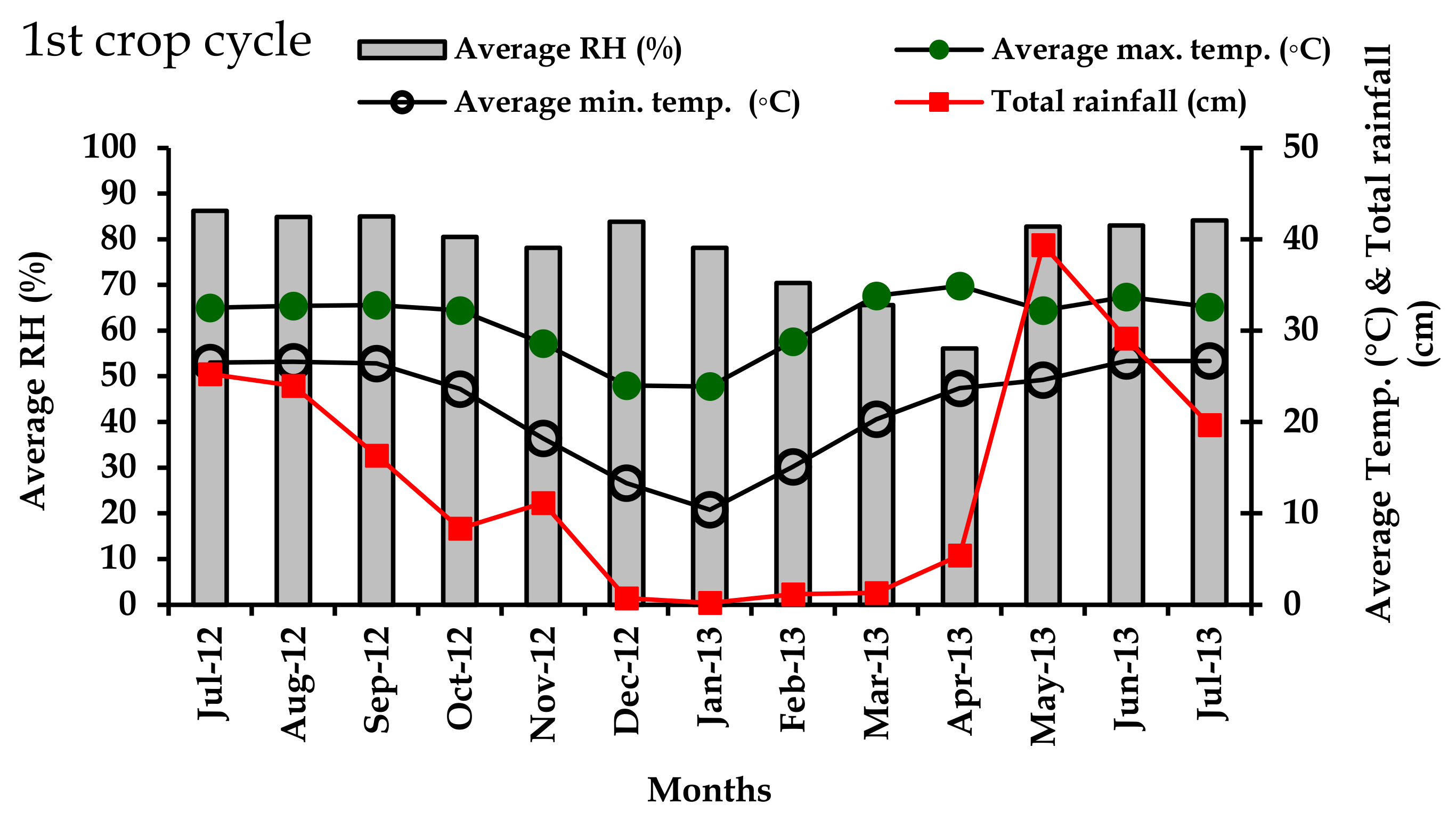
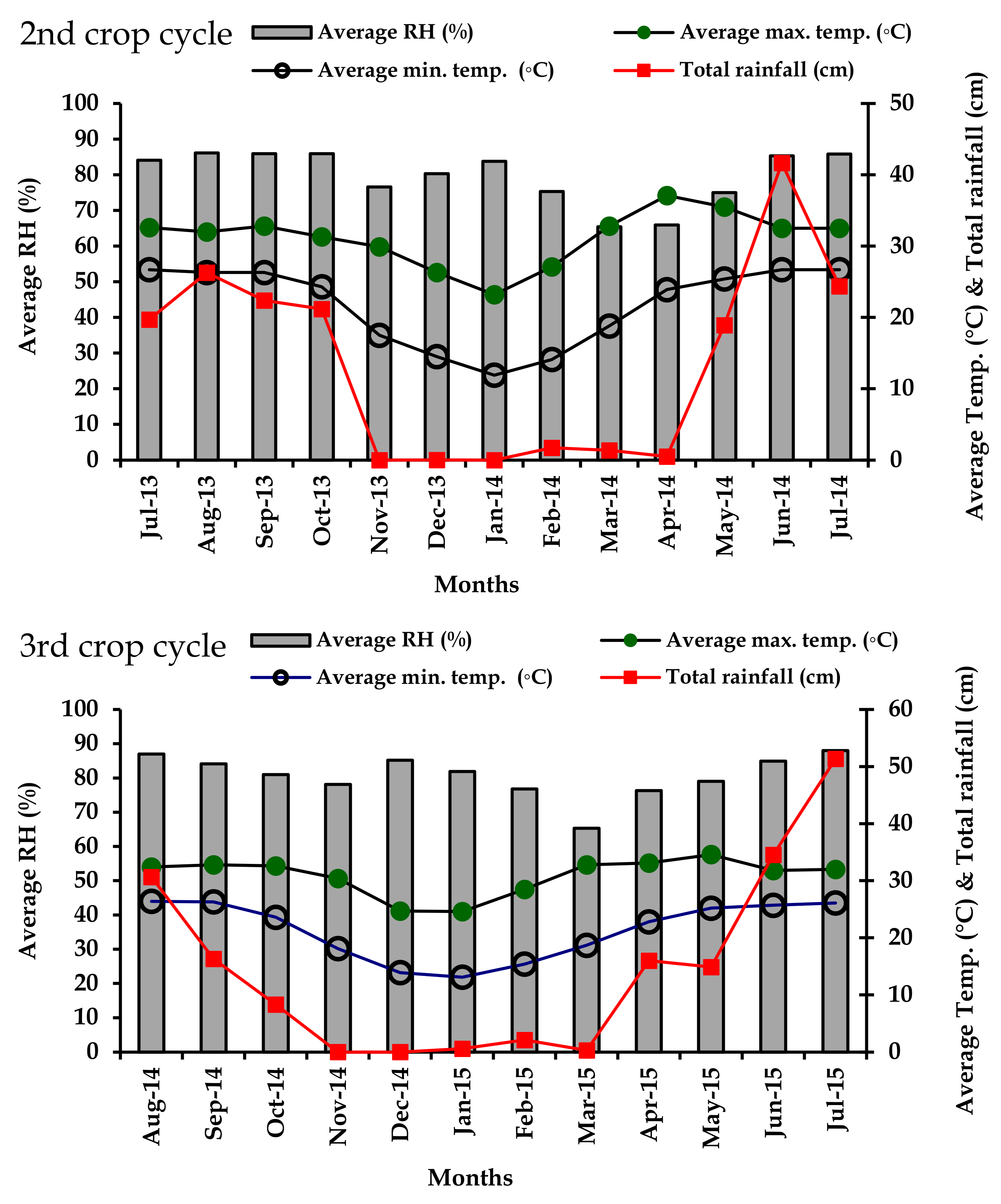
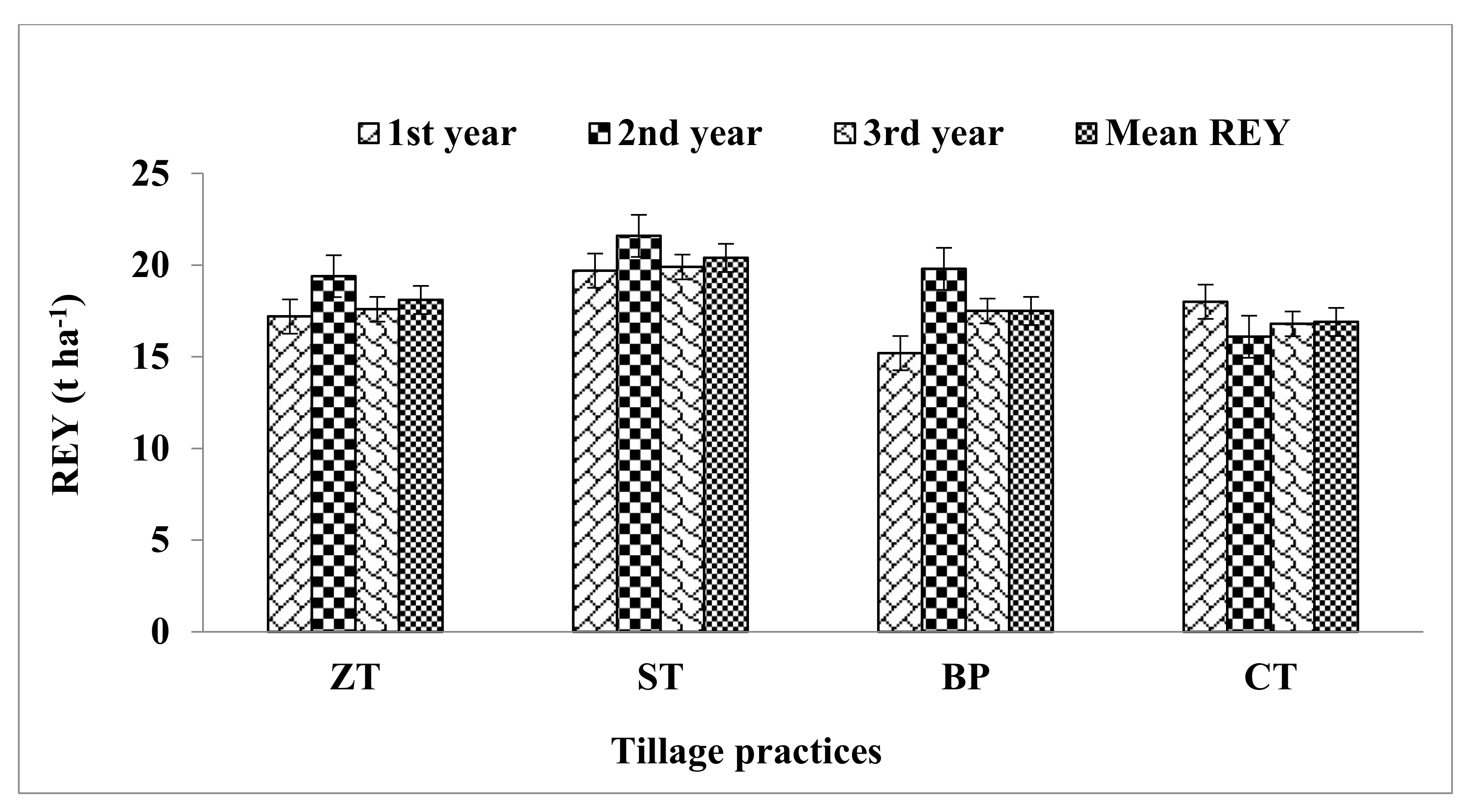
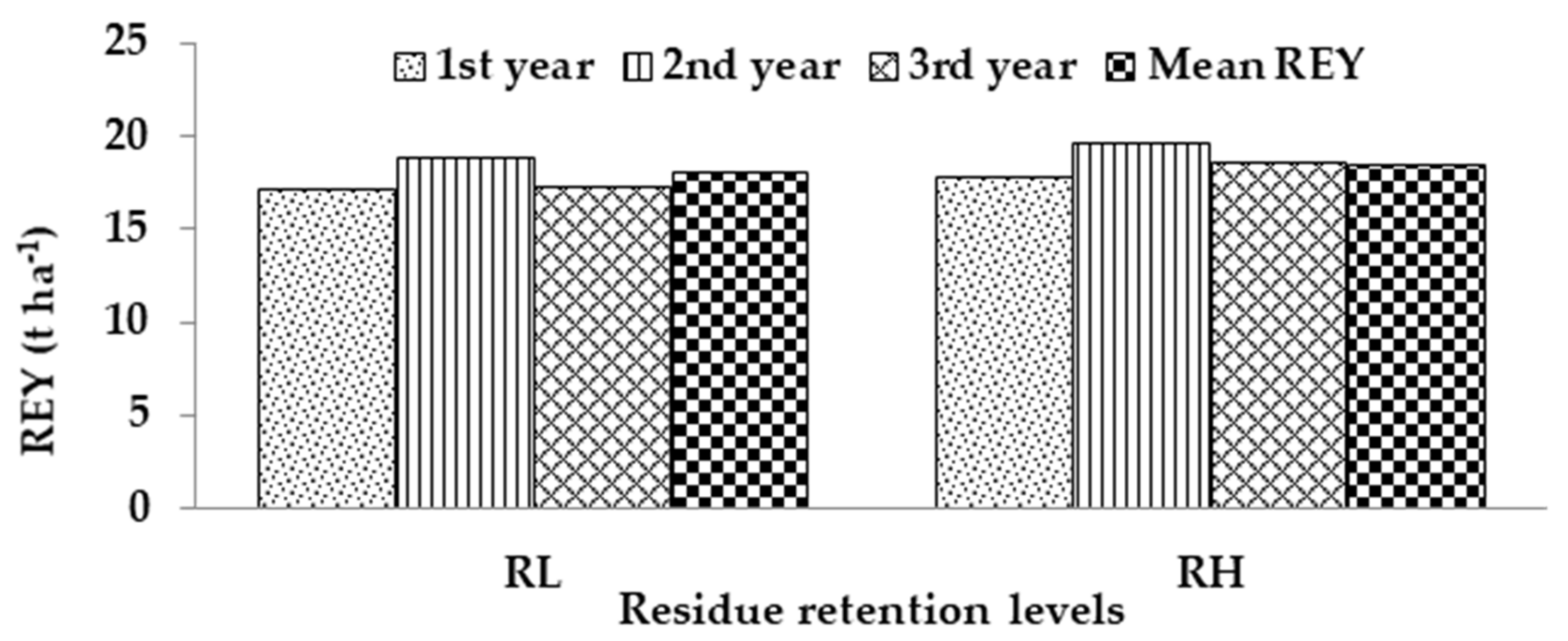
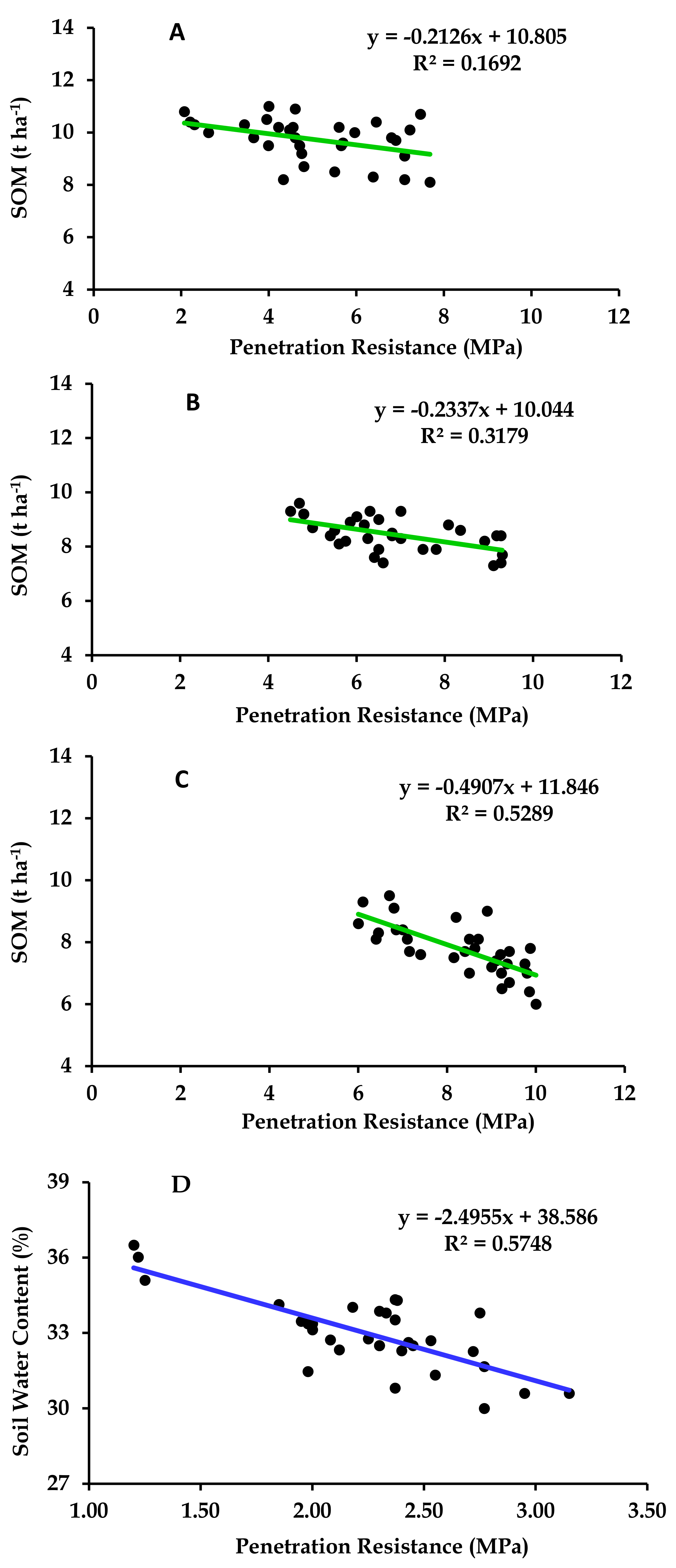
| Residue Retention Levels | Rice Residue 2012 | Lentil Residue 2012–13 | Jute Leaf 2013 | Rice Residue 2013 | Lentil Residue 2013–14 | Jute Leaf 2014 | Rice Residue 2014 | Wheat Residue 2014–15 | Jute Leaf 2015 | Total Residues |
|---|---|---|---|---|---|---|---|---|---|---|
| RL | 1.9 | 0.24 | 2.17 | 2.7 | 0.23 | 1.12 | 2.4 | 2.15 | 1.34 | 14.3 |
| RH | 3.4 | 0.56 | 2.10 | 4.3 | 0.58 | 1.46 | 4.5 | 3.99 | 1.47 | 22.4 |
| LSD0.05 | 0.03 | 0.05 | 0.20 | 0.19 | 0.03 | 0.29 | 0.28 | 0.29 | 0.16 | 0.69 |
| Tillage Practices | Grain Yield of T. aman Rice | Grain Yield of Lentil/Wheat | Fibre Yield of Jute | ||||||
|---|---|---|---|---|---|---|---|---|---|
| RL | RH | Mean | RL | RH | Mean | RL | RH | Mean | |
| 1st year: Rice-Lentil-Jute | |||||||||
| ZT | - | - | 2.66 | 1.45 | 1.35 | 1.40 | 4.50 | 4.72 | 4.61 |
| ST | - | - | 3.24 | 1.81 | 1.72 | 1.76 | 5.32 | 4.06 | 4.69 |
| BP | - | - | 2.88 | 1.52 | 1.49 | 1.51 | 2.85 | 3.11 | 2.98 |
| CT | - | - | 3.70 | 2.01 | 1.95 | 1.98 | 3.64 | 3.44 | 3.54 |
| Mean | - | - | - | 1.70 | 1.63 | - | 4.08 | 3.83 | - |
| LSD0.05 Tillage = 0.69 | Tillage = 0.42, Residue = ns | Tillage = ns, Residue = ns | |||||||
| 2nd year: Rice-Lentil-Jute | |||||||||
| ZT | 5.57 | 5.51 | 5.54 | 1.46 | 1.43 | 1.45 | 4.31 | 4.93 | 4.62 |
| ST | 6.15 | 6.42 | 6.28 | 1.70 | 1.61 | 1.65 | 4.46 | 5.29 | 4.87 |
| BP | 5.72 | 6.02 | 5.87 | 2.00 | 1.86 | 1.93 | 3.12 | 3.66 | 3.39 |
| CT | 5.05 | 5.21 | 5.13 | 1.31 | 1.07 | 1.19 | 3.54 | 3.47 | 3.51 |
| Mean | 5.62 | 5.79 | - | 1.61 | 1.49 | - | 3.86 | 4.34 | - |
| LSD0.05 Tillage = 0.44, Residue = ns | Tillage = 0.29, Residue = 0.09 | Tillage = 1.12, Residue = 0.43 | |||||||
| 3rd year: Rice-Wheat-Jute | |||||||||
| ZT | 4.89 | 5.39 | 5.14 | 4.19 | 4.23 | 4.21 | 3.74 | 3.90 | 3.82 |
| ST | 5.72 | 6.11 | 5.91 | 4.29 | 4.61 | 4.25 | 4.10 | 4.34 | 4.22 |
| BP | 5.17 | 5.87 | 5.52 | 4.24 | 4.28 | 4.26 | 3.18 | 3.43 | 3.30 |
| CT | 4.77 | 5.19 | 4.98 | 4.06 | 4.33 | 4.19 | 3.63 | 3.50 | 3.56 |
| Mean | 5.14 | 5.64 | - | 4.20 | 4.36 | - | 3.66 | 3.79 | - |
| LSD0.05 Tillage = 0.48, Residue = 0.21 | Tillage = ns, Residue = 0.15 | Tillage = 0.63, Residue = 0.13 | |||||||
| Tillage Practices | Bulk Density (g cm−3) | Penetration Resistance (MPa) | Water Content (volume %) | ||||||
|---|---|---|---|---|---|---|---|---|---|
| RL | RH | Mean | RL | RH | Mean | RL | RH | Mean | |
| 0–5 cm soil depth, initial BD 1.51 g cm−3 | |||||||||
| ZT | 1.54 | 1.52 | 1.53 | 4.61 | 4.45 | 4.53 | 13.3 | 13.4 | 13.3 |
| ST | 1.46 | 1.45 | 1.45 | 4.76 | 2.95 | 3.86 | 12.7 | 14.8 | 13.7 |
| BP | 1.51 | 1.49 | 1.50 | 6.91 | 5.95 | 6.43 | 10.2 | 11.4 | 10.8 |
| CT | 1.50 | 1.49 | 1.49 | 5.65 | 4.91 | 5.28 | 12.1 | 13.1 | 12.6 |
| Mean | 1.50 | 1.49 | - | 5.48 | 4.56 | - | 12.1 | 13.2 | - |
| LSD0.05 Tillage = 0.05, Residue = ns | Tillage = 1.78, Residue = 0.82 | Tillage = 2.08, Residue = 0.85 | |||||||
| 5–10 cm soil depth, initial BD 1.53 g cm−3 | |||||||||
| ZT | 1.58 | 1.54 | 1.56 | 7.96 | 6.13 | 7.04 | 14.9 | 18.2 | 16.6 |
| ST | 1.50 | 1.49 | 1.49 | 6.52 | 5.15 | 5.83 | 17.4 | 19.0 | 18.9 |
| BP | 1.54 | 1.55 | 1.54 | 9.21 | 6.44 | 7.82 | 14.6 | 18.0 | 15.3 |
| CT | 1.52 | 1.52 | 1.52 | 7.06 | 5.79 | 6.42 | 16.7 | 18.8 | 17.6 |
| Mean | 1.53 | 1.51 | - | 7.69 | 5.88 | - | 15.9 | 18.5 | - |
| LSD0.05 Tillage = 0.06, Residue = ns | Tillage = 1.36, Residue = 0.60 | Tillage = 2.58, Residue = 1.14 | |||||||
| 10–15 cm soil depth, initial BD 1.55 g cm−3 | |||||||||
| ZT | 1.59 | 1.58 | 1.59 | 9.31 | 7.88 | 8.60 | 15.3 | 18.6 | 17.0 |
| ST | 1.53 | 1.51 | 1.52 | 7.96 | 6.41 | 7.19 | 18.5 | 21.4 | 20.0 |
| BP | 1.57 | 1.56 | 1.56 | 9.76 | 8.31 | 9.03 | 15.1 | 17.4 | 16.2 |
| CT | 1.54 | 1.53 | 1.54 | 9.09 | 7.55 | 8.32 | 16.5 | 20.2 | 18.3 |
| Mean | 1.55 | 1.53 | - | 9.03 | 7.54 | – | 16.4 | 19.4 | - |
| LSD0.05 Tillage = 0.05, Residue = ns | Tillage = 1.26, Residue = 0.44 | Tillage = 2.65, Residue = 1.85 | |||||||
| Tillage Practices | Organic Matter (t ha−1) | Total N (t ha−1) | Available P (mg kg−1) | ||||||
|---|---|---|---|---|---|---|---|---|---|
| RL | RH | Mean | RL | RH | Mean | RL | RH | Mean | |
| 0–5 cm soil depth, initial OM 8.2 t ha−1, N 0.430 t ha−1, P 6.1 mg kg−1 | |||||||||
| ZT | 9.9 | 10.5 | 10.2 | 0.490 | 0.572 | 0.531 | 9.2 | 10.9 | 10.1 |
| ST | 9.2 | 10.6 | 10.1 | 0.481 | 0.530 | 0.509 | 9.1 | 10.7 | 9.9 |
| BP | 9.2 | 10.1 | 9.6 | 0.467 | 0.526 | 0.496 | 8.2 | 10.4 | 9.3 |
| CT | 8.4 | 9.8 | 9.1 | 0.435 | 0.466 | 0.450 | 7.1 | 8.6 | 7.8 |
| Mean | 9.2 | 10.2 | - | 0.468 | 0.525 | - | 8.4 | 10.2 | - |
| LSD0.05 Tillage = 0.6, Residue = 0.4 | Tillage = 0.054, Residue = 0.022 | Tillage = 0.4, Residue = 0.4 | |||||||
| 5–10 cm soil depth, initial OM 7.6 t ha−1, N 0.398 t ha−1, P 5.5 mg kg−1 | |||||||||
| ZT | 8.4 | 9.0 | 8.7 | 0.440 | 0.464 | 0.452 | 7.6 | 9.0 | 8.3 |
| ST | 8.4 | 8.9 | 8.6 | 0.442 | 0.447 | 0.445 | 7.5 | 8.5 | 8.0 |
| BP | 8.0 | 8.4 | 8.2 | 0.416 | 0.438 | 0.432 | 7.2 | 8.3 | 7.7 |
| CT | 8.0 | 8.7 | 8.3 | 0.422 | 0.443 | 0.427 | 6.6 | 7.6 | 7.1 |
| Mean | 8.2 | 8.7 | - | 0.430 | 0.448 | - | 7.2 | 8.4 | - |
| LSD0.05 Tillage = ns, Residue = 0.3 | Tillage = ns, Residue = 0.009 | Tillage = 0.8, Residue = 0.3 | |||||||
| 10–15 cm soil depth, initial OM 6.8 t ha−1, N 0.364 t ha−1, P 4.7 mg kg−1 | |||||||||
| ZT | 6.9 | 8.0 | 7.5 | 0.368 | 0.418 | 0.393 | 6.5 | 7.1 | 6.8 |
| ST | 7.7 | 8.6 | 8.1 | 0.406 | 0.452 | 0.429 | 6.2 | 6.9 | 6.6 |
| BP | 7.0 | 8.1 | 7.5 | 0.372 | 0.423 | 0.400 | 6.3 | 6.4 | 6.3 |
| CT | 7.4 | 8.6 | 8.0 | 0.395 | 0.459 | 0.427 | 5.9 | 6.3 | 6.1 |
| Mean | 7.3 | 8.3 | - | 0.385 | 0.427 | - | 6.2 | 6.7 | - |
| LSD0.05 Tillage = ns, Residue = 0.2 | Tillage = ns, Residue = 0.014 | Tillage = ns, Residue = ns | |||||||
| Tillage Practices | Exchangeable K (cmol kg−1) | Extractable S (mg kg−1) | Extractable Zn (mg kg−1) | ||||||
|---|---|---|---|---|---|---|---|---|---|
| RL | RH | Mean | RL | RH | Mean | RL | RH | Mean | |
| 0–5 cm soil depth, initial K 0.162 cmol kg−1, S 14.6 mg kg−1, Zn 0.32 mg kg−1 | |||||||||
| ZT | 0.220 | 0.275 | 0.248 | 16.5 | 18.8 | 17.7 | 0.43 | 0.54 | 0.49 |
| ST | 0.213 | 0.250 | 0.231 | 16.0 | 18.5 | 17.2 | 0.41 | 0.53 | 0.47 |
| BP | 0.203 | 0.225 | 0.214 | 15.9 | 17.1 | 16.5 | 0.40 | 0.48 | 0.44 |
| CT | 0.185 | 0.223 | 0.204 | 14.7 | 15.8 | 15.6 | 0.37 | 0.44 | 0.40 |
| Mean | 0.205 | 0.243 | - | 15.8 | 17.6 | - | 0.40 | 0.50 | - |
| LSD0.05 Tillage = ns, Residue = 0.01 | Tillage = 0.17, Residue = 0.06 | Tillage = 0.03, Residue = 0.02 | |||||||
| 5–10 cm soil depth, initial K 0.134 cmol kg−1, S 14.4 mg kg−1, Zn 0.22 mg kg−1 | |||||||||
| ZT | 0.185 | 0.223 | 0.204 | 15.6 | 18.5 | 17.0 | 0.28 | 0.35 | 0.31 |
| ST | 0.183 | 0.210 | 0.196 | 15.4 | 17.8 | 16.6 | 0.26 | 0.33 | 0.30 |
| BP | 0.173 | 0.200 | 0.186 | 14.6 | 16.7 | 15.7 | 0.24 | 0.31 | 0.28 |
| CT | 0.160 | 0.188 | 0.174 | 14.1 | 16.2 | 15.1 | 0.23 | 0.30 | 0.26 |
| Mean | 0.175 | 0.205 | - | 14.9 | 17.3 | - | 0.25 | 0.32 | - |
| LSD0.05 Tillage = ns, Residue = 0.01 | Tillage = ns, Residue = 0.76 | Tillage = ns, Residue = 0.02 | |||||||
| 10–15 cm soil depth, initial K 0.125 cmol kg−1, S 13.5 mg kg−1, Zn 0.21 mg kg−1 | |||||||||
| ZT | 0.163 | 0.178 | 0.170 | 14.9 | 17.4 | 16.2 | 0.26 | 0.29 | 0.28 |
| ST | 0.160 | 0.175 | 0.168 | 14.6 | 16.9 | 15.8 | 0.25 | 0.28 | 0.27 |
| BP | 0.148 | 0.170 | 0.159 | 13.9 | 16.0 | 15.0 | 0.24 | 0.27 | 0.25 |
| CT | 0.140 | 0.168 | 0.154 | 13.6 | 15.7 | 14.6 | 0.23 | 0.26 | 0.24 |
| Mean | 0.153 | 0.173 | - | 14.3 | 16.5 | - | 0.24 | 0.27 | - |
| LSD0.05 Tillage = ns, Residue = 0.01 | Tillage = ns, Residue = ns | Tillage = ns, Residue = ns | |||||||
| Particular | ZT | SP | BP | CT |
|---|---|---|---|---|
| 1st year: Rice-Lentil-Jute | ||||
| Gross return (US $ ha−1) | 3732 | 4201 | 3216 | 4065 |
| Total input cost (US $ ha−1) | 2323 | 2272 | 2228 | 2292 |
| Gross margin (US $ ha−1) | 1998 | 2517 | 1576 | 2361 |
| Net return (US $ ha−1) | 1409 | 1929 | 989 | 1773 |
| BCR | 1.61 | 1.85 | 1.44 | 1.77 |
| 2nd year: Rice-Lentil-Jute | ||||
| Gross return (USD ha−1) | 4341 | 4789 | 4430 | 3676 |
| Total input cost (USD ha−1) | 2316 | 2303 | 2367 | 2311 |
| Gross margin (USD ha−1) | 2615 | 3075 | 2654 | 1954 |
| Net return (USD ha−1) | 2026 | 2486 | 2063 | 1365 |
| BCR | 1.87 | 2.08 | 1.87 | 1.59 |
| 3rd year: Rice-Wheat-Jute | ||||
| Gross return (USD ha−1) | 3749 | 4125 | 3682 | 3656 |
| Total input cost (USD ha−1) | 2591 | 2565 | 2565 | 2528 |
| Gross margin (USD ha−1) | 1754 | 2156 | 1713 | 1722 |
| Net return (USD ha−1) | 1158 | 1560 | 1117 | 1128 |
| BCR | 1.45 | 1.61 | 1.44 | 1.45 |
| Average of 3 years | ||||
| Gross return (USD ha−1) | 3941 | 4372 | 3776 | 3799 |
| Total input cost (USD ha−1) | 2410 | 2380 | 2386 | 2377 |
| Gross margin (USD ha−1) | 2122 | 2582 | 1981 | 2013 |
| Net return (USD ha−1) | 1531 | 1992 | 1390 | 1422 |
| BCR | 1.64 | 1.84 | 1.58 | 1.60 |
Publisher’s Note: MDPI stays neutral with regard to jurisdictional claims in published maps and institutional affiliations. |
© 2021 by the authors. Licensee MDPI, Basel, Switzerland. This article is an open access article distributed under the terms and conditions of the Creative Commons Attribution (CC BY) license (https://creativecommons.org/licenses/by/4.0/).
Share and Cite
Salahin, N.; Jahiruddin, M.; Islam, M.R.; Alam, M.K.; Haque, M.E.; Ahmed, S.; Baazeem, A.; Hadifa, A.; EL Sabagh, A.; Bell, R.W. Establishment of Crops under Minimal Soil Disturbance and Crop Residue Retention in Rice-Based Cropping System: Yield Advantage, Soil Health Improvement, and Economic Benefit. Land 2021, 10, 581. https://doi.org/10.3390/land10060581
Salahin N, Jahiruddin M, Islam MR, Alam MK, Haque ME, Ahmed S, Baazeem A, Hadifa A, EL Sabagh A, Bell RW. Establishment of Crops under Minimal Soil Disturbance and Crop Residue Retention in Rice-Based Cropping System: Yield Advantage, Soil Health Improvement, and Economic Benefit. Land. 2021; 10(6):581. https://doi.org/10.3390/land10060581
Chicago/Turabian StyleSalahin, Nazmus, Mohammad Jahiruddin, Mohammad Rafiqul Islam, Md. Khairul Alam, M. Enamul Haque, Sharif Ahmed, Alaa Baazeem, Adel Hadifa, Ayman EL Sabagh, and Richard W. Bell. 2021. "Establishment of Crops under Minimal Soil Disturbance and Crop Residue Retention in Rice-Based Cropping System: Yield Advantage, Soil Health Improvement, and Economic Benefit" Land 10, no. 6: 581. https://doi.org/10.3390/land10060581
APA StyleSalahin, N., Jahiruddin, M., Islam, M. R., Alam, M. K., Haque, M. E., Ahmed, S., Baazeem, A., Hadifa, A., EL Sabagh, A., & Bell, R. W. (2021). Establishment of Crops under Minimal Soil Disturbance and Crop Residue Retention in Rice-Based Cropping System: Yield Advantage, Soil Health Improvement, and Economic Benefit. Land, 10(6), 581. https://doi.org/10.3390/land10060581









